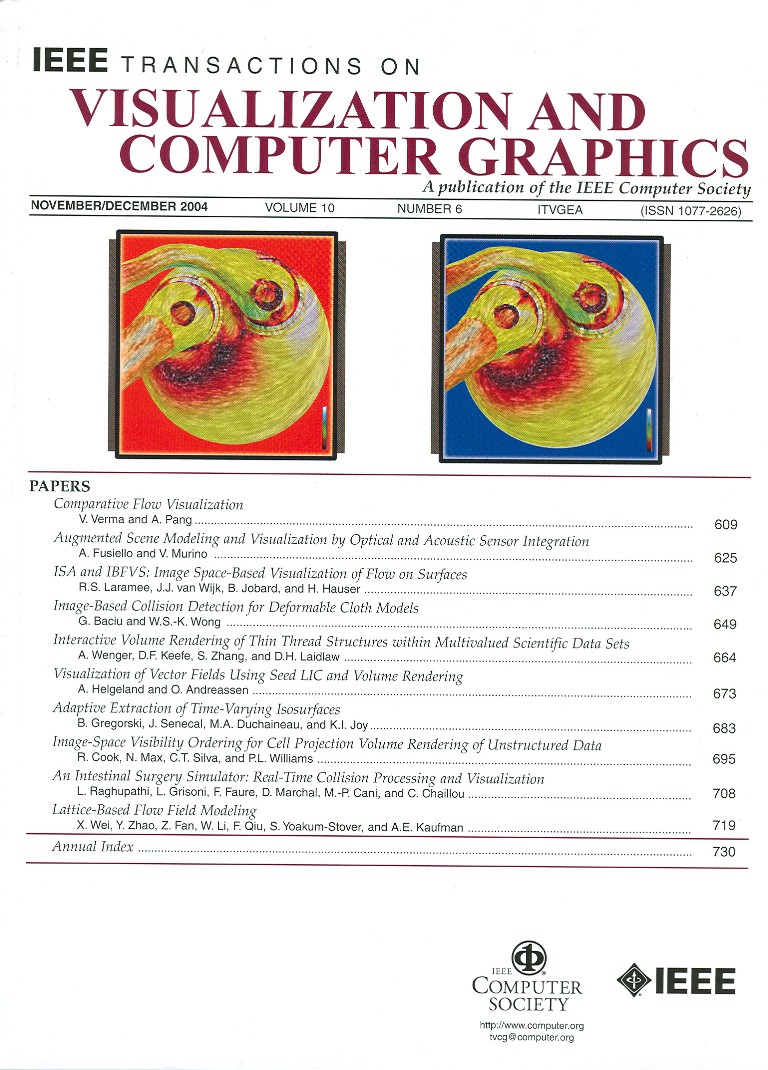| ISA and IBFVS: Image Space Based Visualization of Flow on Surfaces |

|

|
We present a side-by-side analysis of two recent image space approaches for the visualization of vector fields on surfaces. The two methods, Image Space Advection (ISA) and Image Based Flow Visualization for Curved Surfaces (IBFVS) generate dense representations of time-dependent vector fields with high spatio-temporal correlation. While the 3D vector fields are associated with arbitrary surfaces represented by triangular meshes, the generation and advection of texture properties is confined to image space. Fast frame rates are achieved by exploiting frame-to-frame coherency and graphics hardware. In our comparison of ISA and IBFVS we point out the strengths and weaknesses of each approach and give recommendations as to when and where they are best applied.
See also the e-cover of IEEE TVCG Vol. 10, No. 6

Visualization of flow at the complex surface of a cooling jacket -a composite of over 228,000 polygons. (ISA, 300 frames)
The average wind stress in January visualized at the earth's surface. The magnitude of the stress is visualized via color. (IBFVS)
A side view of the surface of an 221K polygonal intake port mesh. Texture-based flow visualization is applied to the surface. User-controlled rotation is illustrated. (ISA, 650 frames)
Visualization of flow at the surface of the famous Stanford bunny. (IBFVS)
A close-up, top view of the surface of the intake port mesh show. Here we illustrate user-supported zooming with automatic, on the fly recalculation of the flow texture. A low-contrast velocity mask is used to dim the texture in areas of low velocity magnitude. (ISA, 600 frames)
A close-up visualization of flow at the surface of the famous Stanford bunny. (IBFVS)
Medical visualization: blood flow at the surface of the junction of three blood vessels. Stagnant blood flow may occur within the abnormal pocket at the junction. Here a velocity clamp is used to achieve LIC-like texture synthesis. (ISA, 650 frames).
Surface Visualization: Moving particles on the surface of a torso. The moving particles are implemented using a sparse texture. (IBFVS)
The visualization of a time-dependent surface mesh composed of a 79K polygons (at largest point) with dynamic geometry and topology. This intake valve and piston cylinder can also be used to analyse the formation of wall film, the term used to describe the liquid buildup on surfaces. (ISA, 900 frames)
Surface Visualization: Moving texture on the surface of a torso. (IBFVS)
The visualization of aerodynamic flow around a ski jumper. This view is looking down on the ski jumper. (ISA, 150 frames)
The average wind stress field on the earth for January. A map of the world is shown, and the strength of the texture is modulated with the magnitude of the stress. (IBFVS)
The visualization of flow at the surface of a cooling jacket. Here, areas of flow with a low magnitude are highlighted in yellow. Slow flow can lead to harmful boiling conditions in the cooling jacket. (ISA, F500 frames)
The visualization of flow on the other side of the intake port data set. Here we can see the formation of a tumble swirl flow pattern sought after by the designers of the model. A low-contrast velocity mask has been applied to dim areas of low velocity magnitude. (ISA, 1100 frames)